Developing Individual, Teams and Organizations in Whirlpool.
VerifiedAdded on 2023/02/06
|14
|3667
|72
AI Summary
Contribute Materials
Your contribution can guide someone’s learning journey. Share your
documents today.
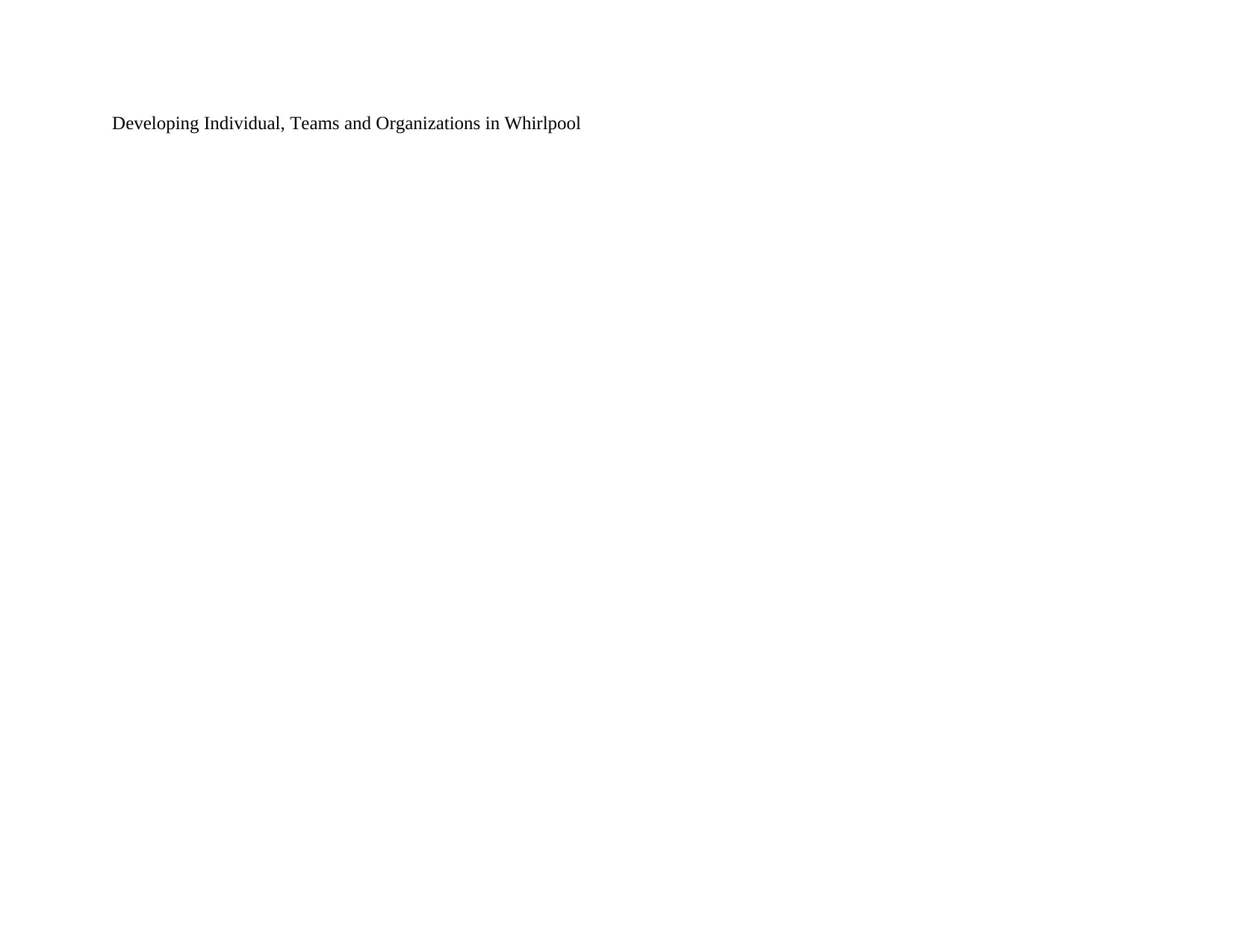
Developing Individual, Teams and Organizations in Whirlpool
Secure Best Marks with AI Grader
Need help grading? Try our AI Grader for instant feedback on your assignments.
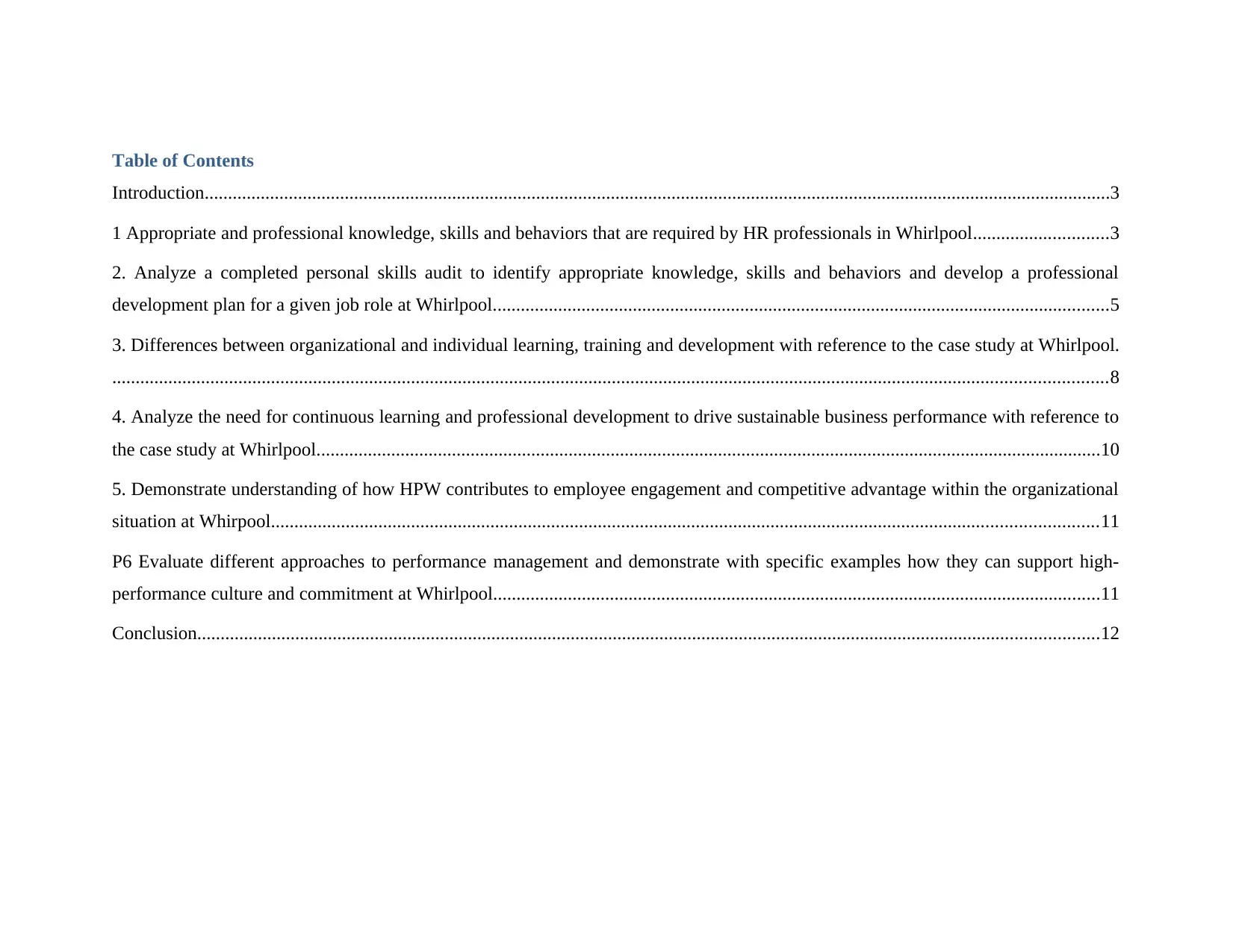
Table of Contents
Introduction..................................................................................................................................................................................................3
1 Appropriate and professional knowledge, skills and behaviors that are required by HR professionals in Whirlpool.............................3
2. Analyze a completed personal skills audit to identify appropriate knowledge, skills and behaviors and develop a professional
development plan for a given job role at Whirlpool....................................................................................................................................5
3. Differences between organizational and individual learning, training and development with reference to the case study at Whirlpool.
.....................................................................................................................................................................................................................8
4. Analyze the need for continuous learning and professional development to drive sustainable business performance with reference to
the case study at Whirlpool........................................................................................................................................................................10
5. Demonstrate understanding of how HPW contributes to employee engagement and competitive advantage within the organizational
situation at Whirpool.................................................................................................................................................................................11
P6 Evaluate different approaches to performance management and demonstrate with specific examples how they can support high-
performance culture and commitment at Whirlpool..................................................................................................................................11
Conclusion.................................................................................................................................................................................................12
Introduction..................................................................................................................................................................................................3
1 Appropriate and professional knowledge, skills and behaviors that are required by HR professionals in Whirlpool.............................3
2. Analyze a completed personal skills audit to identify appropriate knowledge, skills and behaviors and develop a professional
development plan for a given job role at Whirlpool....................................................................................................................................5
3. Differences between organizational and individual learning, training and development with reference to the case study at Whirlpool.
.....................................................................................................................................................................................................................8
4. Analyze the need for continuous learning and professional development to drive sustainable business performance with reference to
the case study at Whirlpool........................................................................................................................................................................10
5. Demonstrate understanding of how HPW contributes to employee engagement and competitive advantage within the organizational
situation at Whirpool.................................................................................................................................................................................11
P6 Evaluate different approaches to performance management and demonstrate with specific examples how they can support high-
performance culture and commitment at Whirlpool..................................................................................................................................11
Conclusion.................................................................................................................................................................................................12
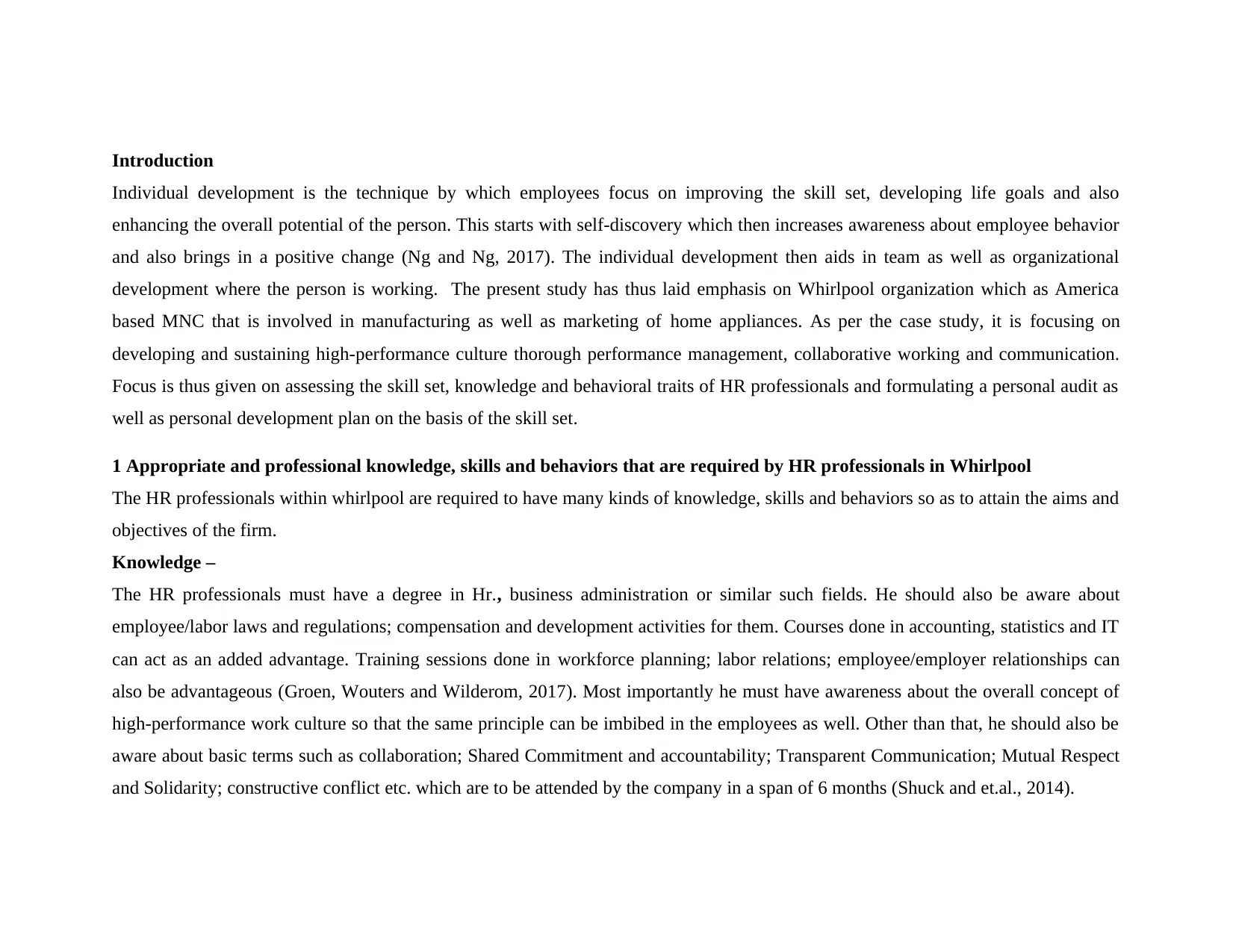
Introduction
Individual development is the technique by which employees focus on improving the skill set, developing life goals and also
enhancing the overall potential of the person. This starts with self-discovery which then increases awareness about employee behavior
and also brings in a positive change (Ng and Ng, 2017). The individual development then aids in team as well as organizational
development where the person is working. The present study has thus laid emphasis on Whirlpool organization which as America
based MNC that is involved in manufacturing as well as marketing of home appliances. As per the case study, it is focusing on
developing and sustaining high-performance culture thorough performance management, collaborative working and communication.
Focus is thus given on assessing the skill set, knowledge and behavioral traits of HR professionals and formulating a personal audit as
well as personal development plan on the basis of the skill set.
1 Appropriate and professional knowledge, skills and behaviors that are required by HR professionals in Whirlpool
The HR professionals within whirlpool are required to have many kinds of knowledge, skills and behaviors so as to attain the aims and
objectives of the firm.
Knowledge –
The HR professionals must have a degree in Hr., business administration or similar such fields. He should also be aware about
employee/labor laws and regulations; compensation and development activities for them. Courses done in accounting, statistics and IT
can act as an added advantage. Training sessions done in workforce planning; labor relations; employee/employer relationships can
also be advantageous (Groen, Wouters and Wilderom, 2017). Most importantly he must have awareness about the overall concept of
high-performance work culture so that the same principle can be imbibed in the employees as well. Other than that, he should also be
aware about basic terms such as collaboration; Shared Commitment and accountability; Transparent Communication; Mutual Respect
and Solidarity; constructive conflict etc. which are to be attended by the company in a span of 6 months (Shuck and et.al., 2014).
Individual development is the technique by which employees focus on improving the skill set, developing life goals and also
enhancing the overall potential of the person. This starts with self-discovery which then increases awareness about employee behavior
and also brings in a positive change (Ng and Ng, 2017). The individual development then aids in team as well as organizational
development where the person is working. The present study has thus laid emphasis on Whirlpool organization which as America
based MNC that is involved in manufacturing as well as marketing of home appliances. As per the case study, it is focusing on
developing and sustaining high-performance culture thorough performance management, collaborative working and communication.
Focus is thus given on assessing the skill set, knowledge and behavioral traits of HR professionals and formulating a personal audit as
well as personal development plan on the basis of the skill set.
1 Appropriate and professional knowledge, skills and behaviors that are required by HR professionals in Whirlpool
The HR professionals within whirlpool are required to have many kinds of knowledge, skills and behaviors so as to attain the aims and
objectives of the firm.
Knowledge –
The HR professionals must have a degree in Hr., business administration or similar such fields. He should also be aware about
employee/labor laws and regulations; compensation and development activities for them. Courses done in accounting, statistics and IT
can act as an added advantage. Training sessions done in workforce planning; labor relations; employee/employer relationships can
also be advantageous (Groen, Wouters and Wilderom, 2017). Most importantly he must have awareness about the overall concept of
high-performance work culture so that the same principle can be imbibed in the employees as well. Other than that, he should also be
aware about basic terms such as collaboration; Shared Commitment and accountability; Transparent Communication; Mutual Respect
and Solidarity; constructive conflict etc. which are to be attended by the company in a span of 6 months (Shuck and et.al., 2014).
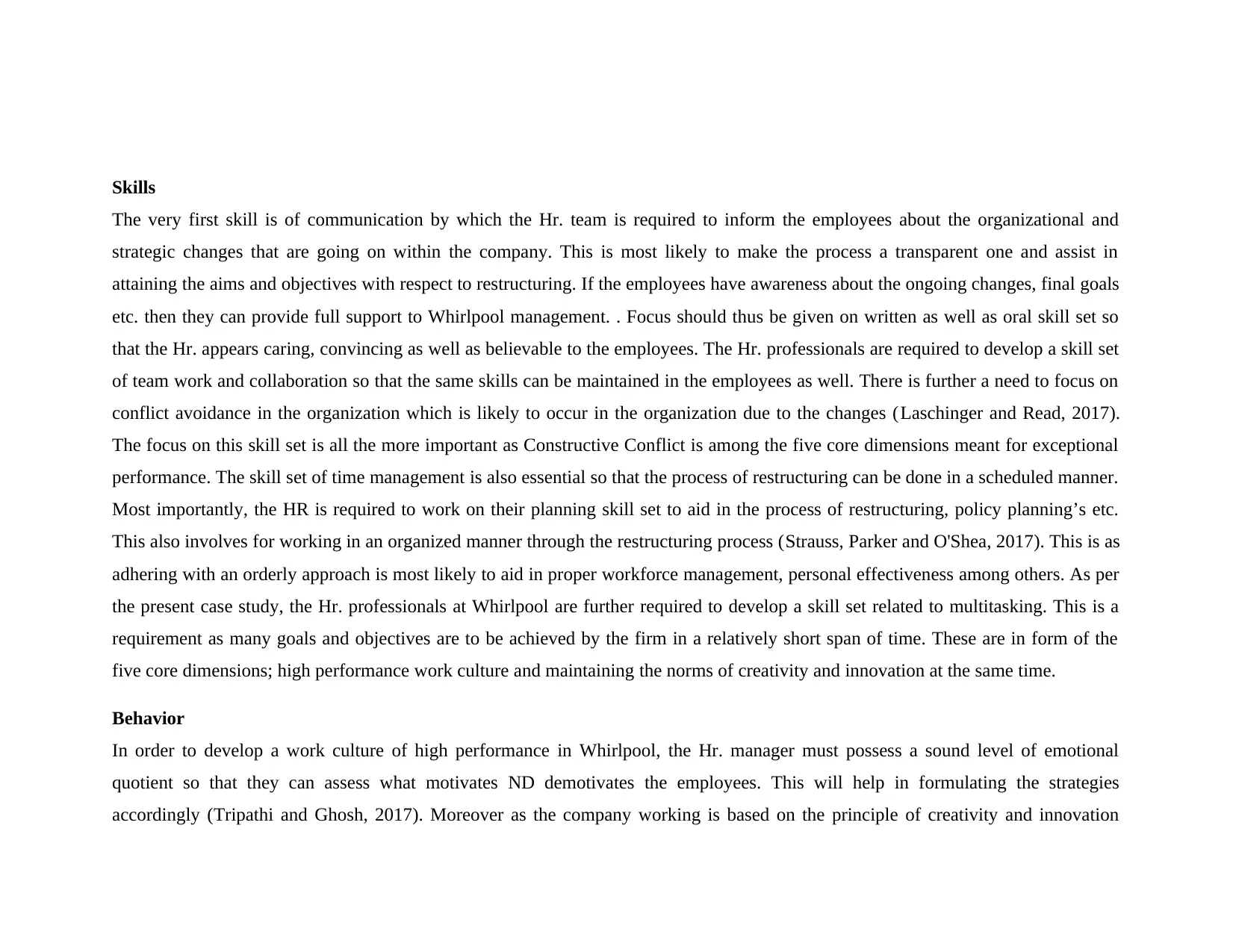
Skills
The very first skill is of communication by which the Hr. team is required to inform the employees about the organizational and
strategic changes that are going on within the company. This is most likely to make the process a transparent one and assist in
attaining the aims and objectives with respect to restructuring. If the employees have awareness about the ongoing changes, final goals
etc. then they can provide full support to Whirlpool management. . Focus should thus be given on written as well as oral skill set so
that the Hr. appears caring, convincing as well as believable to the employees. The Hr. professionals are required to develop a skill set
of team work and collaboration so that the same skills can be maintained in the employees as well. There is further a need to focus on
conflict avoidance in the organization which is likely to occur in the organization due to the changes (Laschinger and Read, 2017).
The focus on this skill set is all the more important as Constructive Conflict is among the five core dimensions meant for exceptional
performance. The skill set of time management is also essential so that the process of restructuring can be done in a scheduled manner.
Most importantly, the HR is required to work on their planning skill set to aid in the process of restructuring, policy planning’s etc.
This also involves for working in an organized manner through the restructuring process (Strauss, Parker and O'Shea, 2017). This is as
adhering with an orderly approach is most likely to aid in proper workforce management, personal effectiveness among others. As per
the present case study, the Hr. professionals at Whirlpool are further required to develop a skill set related to multitasking. This is a
requirement as many goals and objectives are to be achieved by the firm in a relatively short span of time. These are in form of the
five core dimensions; high performance work culture and maintaining the norms of creativity and innovation at the same time.
Behavior
In order to develop a work culture of high performance in Whirlpool, the Hr. manager must possess a sound level of emotional
quotient so that they can assess what motivates ND demotivates the employees. This will help in formulating the strategies
accordingly (Tripathi and Ghosh, 2017). Moreover as the company working is based on the principle of creativity and innovation
The very first skill is of communication by which the Hr. team is required to inform the employees about the organizational and
strategic changes that are going on within the company. This is most likely to make the process a transparent one and assist in
attaining the aims and objectives with respect to restructuring. If the employees have awareness about the ongoing changes, final goals
etc. then they can provide full support to Whirlpool management. . Focus should thus be given on written as well as oral skill set so
that the Hr. appears caring, convincing as well as believable to the employees. The Hr. professionals are required to develop a skill set
of team work and collaboration so that the same skills can be maintained in the employees as well. There is further a need to focus on
conflict avoidance in the organization which is likely to occur in the organization due to the changes (Laschinger and Read, 2017).
The focus on this skill set is all the more important as Constructive Conflict is among the five core dimensions meant for exceptional
performance. The skill set of time management is also essential so that the process of restructuring can be done in a scheduled manner.
Most importantly, the HR is required to work on their planning skill set to aid in the process of restructuring, policy planning’s etc.
This also involves for working in an organized manner through the restructuring process (Strauss, Parker and O'Shea, 2017). This is as
adhering with an orderly approach is most likely to aid in proper workforce management, personal effectiveness among others. As per
the present case study, the Hr. professionals at Whirlpool are further required to develop a skill set related to multitasking. This is a
requirement as many goals and objectives are to be achieved by the firm in a relatively short span of time. These are in form of the
five core dimensions; high performance work culture and maintaining the norms of creativity and innovation at the same time.
Behavior
In order to develop a work culture of high performance in Whirlpool, the Hr. manager must possess a sound level of emotional
quotient so that they can assess what motivates ND demotivates the employees. This will help in formulating the strategies
accordingly (Tripathi and Ghosh, 2017). Moreover as the company working is based on the principle of creativity and innovation
Secure Best Marks with AI Grader
Need help grading? Try our AI Grader for instant feedback on your assignments.
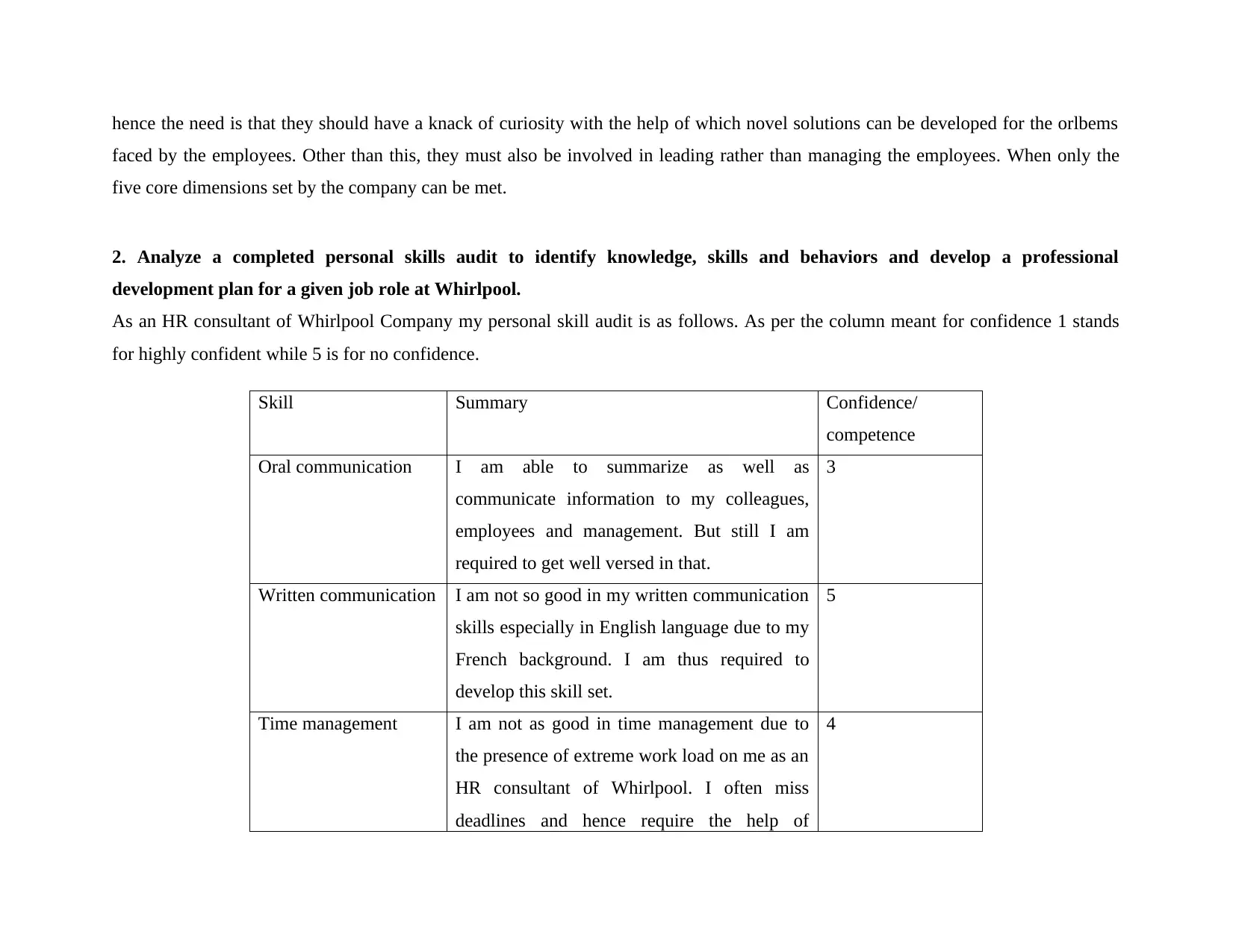
hence the need is that they should have a knack of curiosity with the help of which novel solutions can be developed for the orlbems
faced by the employees. Other than this, they must also be involved in leading rather than managing the employees. When only the
five core dimensions set by the company can be met.
2. Analyze a completed personal skills audit to identify knowledge, skills and behaviors and develop a professional
development plan for a given job role at Whirlpool.
As an HR consultant of Whirlpool Company my personal skill audit is as follows. As per the column meant for confidence 1 stands
for highly confident while 5 is for no confidence.
Skill Summary Confidence/
competence
Oral communication I am able to summarize as well as
communicate information to my colleagues,
employees and management. But still I am
required to get well versed in that.
3
Written communication I am not so good in my written communication
skills especially in English language due to my
French background. I am thus required to
develop this skill set.
5
Time management I am not as good in time management due to
the presence of extreme work load on me as an
HR consultant of Whirlpool. I often miss
deadlines and hence require the help of
4
faced by the employees. Other than this, they must also be involved in leading rather than managing the employees. When only the
five core dimensions set by the company can be met.
2. Analyze a completed personal skills audit to identify knowledge, skills and behaviors and develop a professional
development plan for a given job role at Whirlpool.
As an HR consultant of Whirlpool Company my personal skill audit is as follows. As per the column meant for confidence 1 stands
for highly confident while 5 is for no confidence.
Skill Summary Confidence/
competence
Oral communication I am able to summarize as well as
communicate information to my colleagues,
employees and management. But still I am
required to get well versed in that.
3
Written communication I am not so good in my written communication
skills especially in English language due to my
French background. I am thus required to
develop this skill set.
5
Time management I am not as good in time management due to
the presence of extreme work load on me as an
HR consultant of Whirlpool. I often miss
deadlines and hence require the help of
4
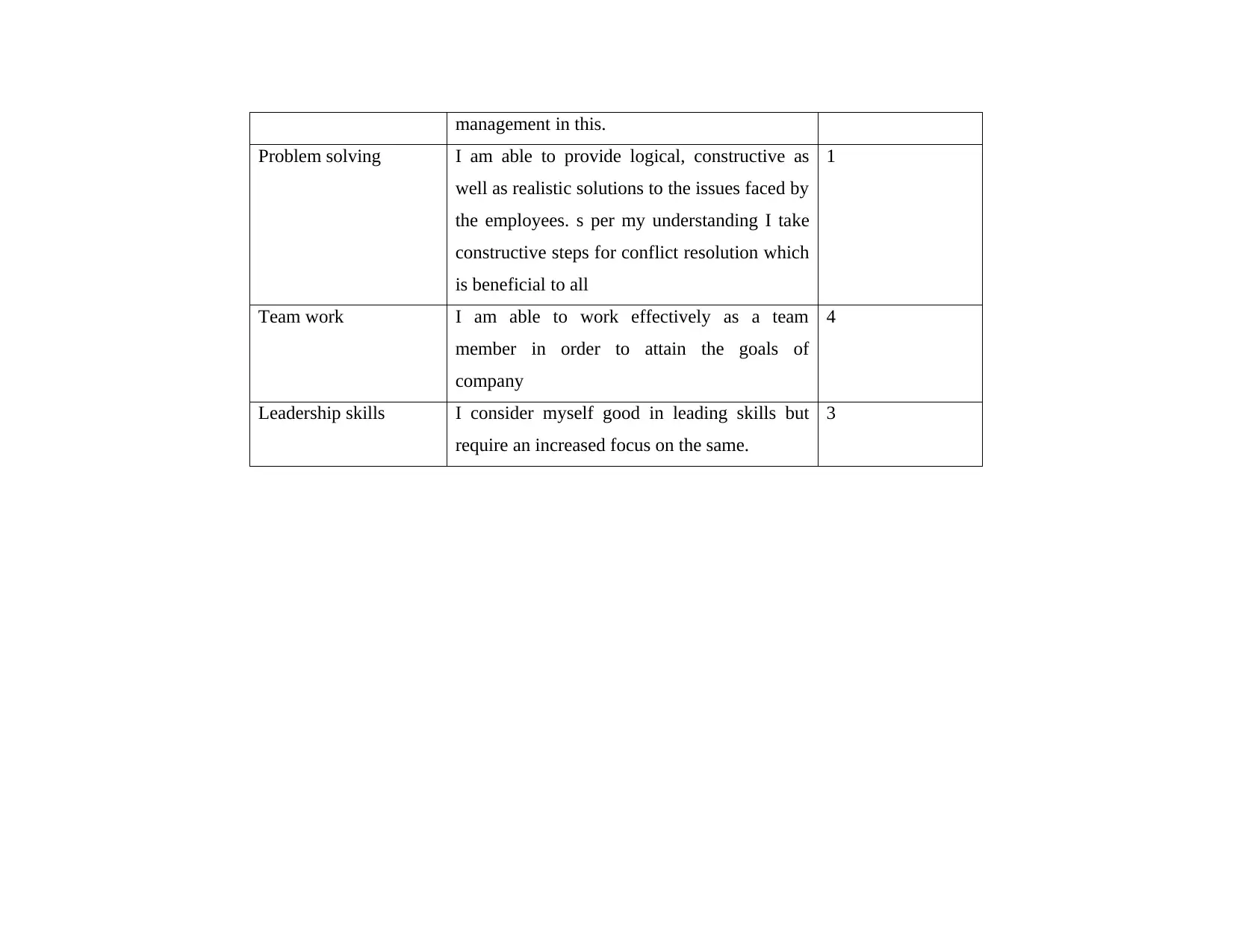
management in this.
Problem solving I am able to provide logical, constructive as
well as realistic solutions to the issues faced by
the employees. s per my understanding I take
constructive steps for conflict resolution which
is beneficial to all
1
Team work I am able to work effectively as a team
member in order to attain the goals of
company
4
Leadership skills I consider myself good in leading skills but
require an increased focus on the same.
3
Problem solving I am able to provide logical, constructive as
well as realistic solutions to the issues faced by
the employees. s per my understanding I take
constructive steps for conflict resolution which
is beneficial to all
1
Team work I am able to work effectively as a team
member in order to attain the goals of
company
4
Leadership skills I consider myself good in leading skills but
require an increased focus on the same.
3
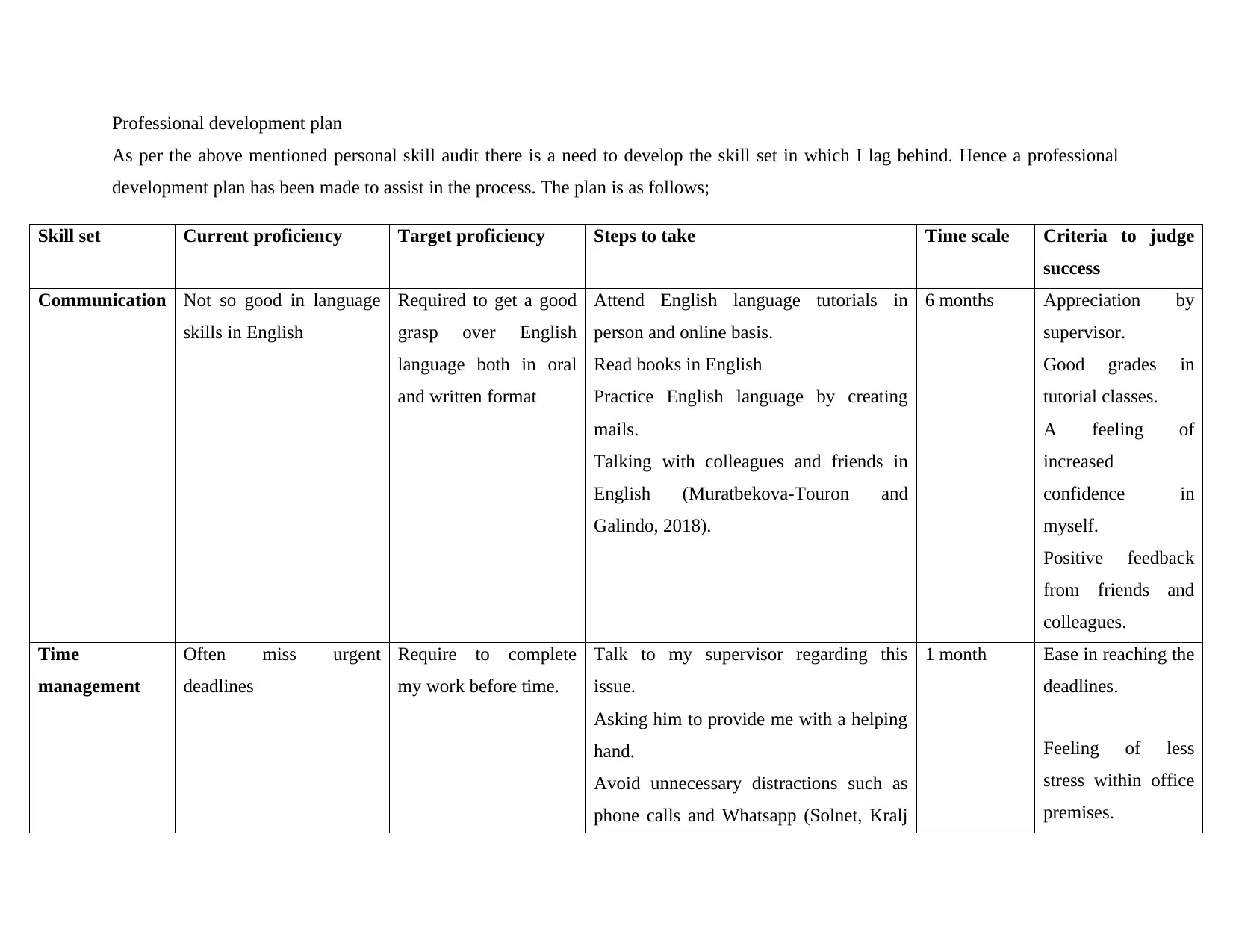
Professional development plan
As per the above mentioned personal skill audit there is a need to develop the skill set in which I lag behind. Hence a professional
development plan has been made to assist in the process. The plan is as follows;
Skill set Current proficiency Target proficiency Steps to take Time scale Criteria to judge
success
Communication Not so good in language
skills in English
Required to get a good
grasp over English
language both in oral
and written format
Attend English language tutorials in
person and online basis.
Read books in English
Practice English language by creating
mails.
Talking with colleagues and friends in
English (Muratbekova-Touron and
Galindo, 2018).
6 months Appreciation by
supervisor.
Good grades in
tutorial classes.
A feeling of
increased
confidence in
myself.
Positive feedback
from friends and
colleagues.
Time
management
Often miss urgent
deadlines
Require to complete
my work before time.
Talk to my supervisor regarding this
issue.
Asking him to provide me with a helping
hand.
Avoid unnecessary distractions such as
phone calls and Whatsapp (Solnet, Kralj
1 month Ease in reaching the
deadlines.
Feeling of less
stress within office
premises.
As per the above mentioned personal skill audit there is a need to develop the skill set in which I lag behind. Hence a professional
development plan has been made to assist in the process. The plan is as follows;
Skill set Current proficiency Target proficiency Steps to take Time scale Criteria to judge
success
Communication Not so good in language
skills in English
Required to get a good
grasp over English
language both in oral
and written format
Attend English language tutorials in
person and online basis.
Read books in English
Practice English language by creating
mails.
Talking with colleagues and friends in
English (Muratbekova-Touron and
Galindo, 2018).
6 months Appreciation by
supervisor.
Good grades in
tutorial classes.
A feeling of
increased
confidence in
myself.
Positive feedback
from friends and
colleagues.
Time
management
Often miss urgent
deadlines
Require to complete
my work before time.
Talk to my supervisor regarding this
issue.
Asking him to provide me with a helping
hand.
Avoid unnecessary distractions such as
phone calls and Whatsapp (Solnet, Kralj
1 month Ease in reaching the
deadlines.
Feeling of less
stress within office
premises.
Paraphrase This Document
Need a fresh take? Get an instant paraphrase of this document with our AI Paraphraser
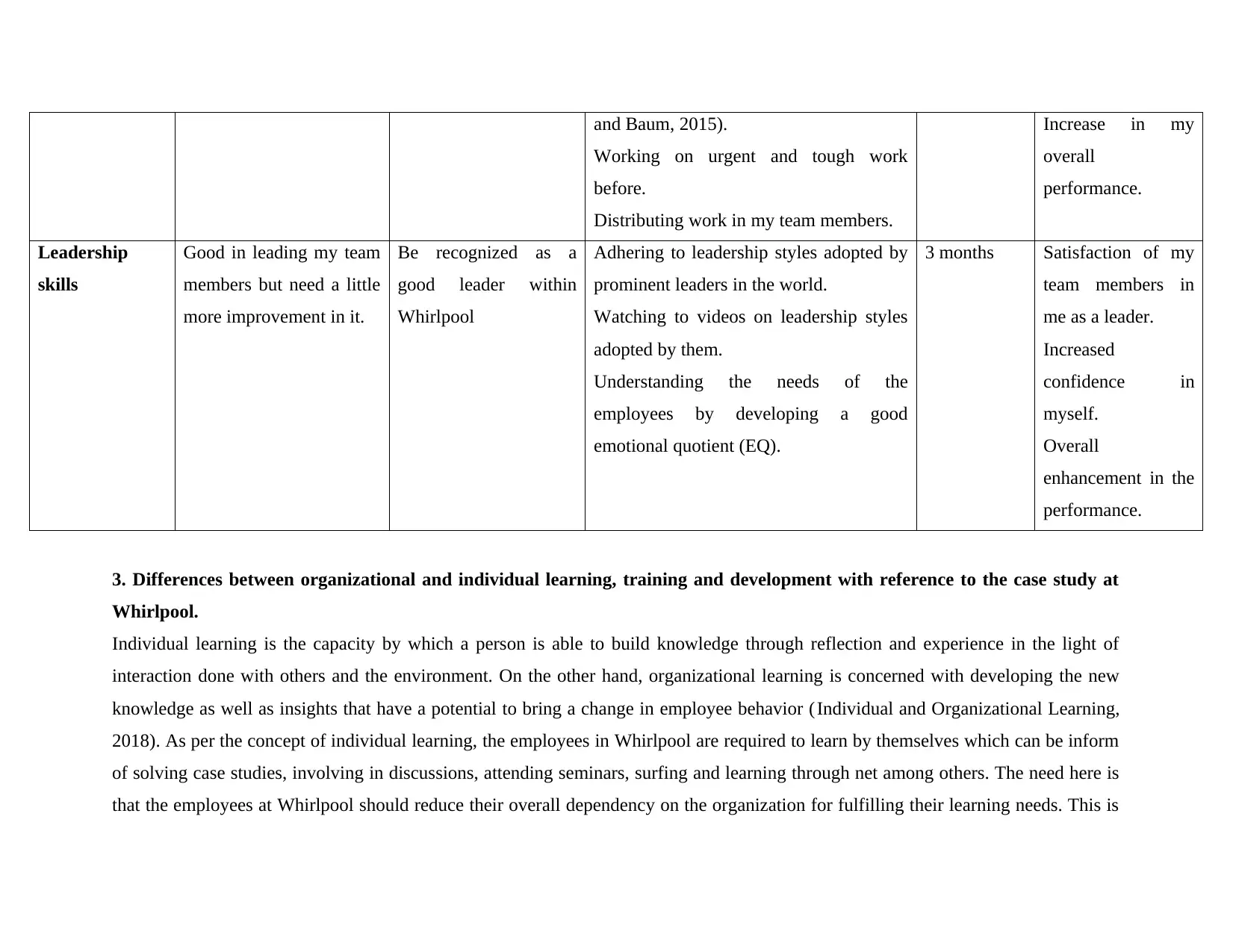
and Baum, 2015).
Working on urgent and tough work
before.
Distributing work in my team members.
Increase in my
overall
performance.
Leadership
skills
Good in leading my team
members but need a little
more improvement in it.
Be recognized as a
good leader within
Whirlpool
Adhering to leadership styles adopted by
prominent leaders in the world.
Watching to videos on leadership styles
adopted by them.
Understanding the needs of the
employees by developing a good
emotional quotient (EQ).
3 months Satisfaction of my
team members in
me as a leader.
Increased
confidence in
myself.
Overall
enhancement in the
performance.
3. Differences between organizational and individual learning, training and development with reference to the case study at
Whirlpool.
Individual learning is the capacity by which a person is able to build knowledge through reflection and experience in the light of
interaction done with others and the environment. On the other hand, organizational learning is concerned with developing the new
knowledge as well as insights that have a potential to bring a change in employee behavior (Individual and Organizational Learning,
2018). As per the concept of individual learning, the employees in Whirlpool are required to learn by themselves which can be inform
of solving case studies, involving in discussions, attending seminars, surfing and learning through net among others. The need here is
that the employees at Whirlpool should reduce their overall dependency on the organization for fulfilling their learning needs. This is
Working on urgent and tough work
before.
Distributing work in my team members.
Increase in my
overall
performance.
Leadership
skills
Good in leading my team
members but need a little
more improvement in it.
Be recognized as a
good leader within
Whirlpool
Adhering to leadership styles adopted by
prominent leaders in the world.
Watching to videos on leadership styles
adopted by them.
Understanding the needs of the
employees by developing a good
emotional quotient (EQ).
3 months Satisfaction of my
team members in
me as a leader.
Increased
confidence in
myself.
Overall
enhancement in the
performance.
3. Differences between organizational and individual learning, training and development with reference to the case study at
Whirlpool.
Individual learning is the capacity by which a person is able to build knowledge through reflection and experience in the light of
interaction done with others and the environment. On the other hand, organizational learning is concerned with developing the new
knowledge as well as insights that have a potential to bring a change in employee behavior (Individual and Organizational Learning,
2018). As per the concept of individual learning, the employees in Whirlpool are required to learn by themselves which can be inform
of solving case studies, involving in discussions, attending seminars, surfing and learning through net among others. The need here is
that the employees at Whirlpool should reduce their overall dependency on the organization for fulfilling their learning needs. This is

also a key requirement of high performance work culture which is to be adopted by Whirlpool. Hence, they must develop a knack for
developing their own skill set and should always be ready to try out new areas of working. The learning should be such that it is able
to bring a change in their overall behavioural traits which not only increases their own performance but also of the entire organization.
On the other hand, as per the concept of organizational learning, the management staff must embed new learning’s into overall
patterns of whirlpool by providing necessary resources and training session to the employees (Mathieu and et.al., 2014). Hence the
management at Whirlpool must focus on a set of activities such systematic problem solving, quick transfer of knowledge, allowing the
employees to carry out experimentation with new approaches among others. Overall focus of the management should be on creation of
the systems and processes that support the activities and integrate them into daily operations so as to manage the learning process in an
effective manner,
Both the above mentioned forms of learning are required in order to become a high performance firm. The management at Whirlpool
is further required to understand that both the forms of learning are a part of a cycle as when employees in the company will learn then
it will impact the process of organizational learning as well.
Training has been defined as a learning approach where employees get a chance to develop the necessary skill set, competence as well
as knowledge that is required in a current job. On the other hand development is an educational approach which focuses on the overall
development of employees. Both forms of learning are being training and development are required to be imparted to the employees
of Whirlpool (Tu, Lu and Yu, 2017). In this regard, the employees can be imparted training in specific work or job roles such as
working on a new software; tools of quality management; to train HR on how an interview is to be taken. While development
activities can be done to enhance general skill set such as leadership; upcoming career roles and developing the employees on future
possibilities within Whirlpool and elsewhere. In the present times, Whirlpool has focused on many development activities for its
workforce such as starting programs related to leadership and talent development. The Leadership Development Program for instance
focuses on placing the young employees on challenging job roles which helps to develop and drive differentiated results followed by
giving them a chance by which they can make a huge impact on the work and community (Ng and Ng, 2017). Similarly in the area of
developing their own skill set and should always be ready to try out new areas of working. The learning should be such that it is able
to bring a change in their overall behavioural traits which not only increases their own performance but also of the entire organization.
On the other hand, as per the concept of organizational learning, the management staff must embed new learning’s into overall
patterns of whirlpool by providing necessary resources and training session to the employees (Mathieu and et.al., 2014). Hence the
management at Whirlpool must focus on a set of activities such systematic problem solving, quick transfer of knowledge, allowing the
employees to carry out experimentation with new approaches among others. Overall focus of the management should be on creation of
the systems and processes that support the activities and integrate them into daily operations so as to manage the learning process in an
effective manner,
Both the above mentioned forms of learning are required in order to become a high performance firm. The management at Whirlpool
is further required to understand that both the forms of learning are a part of a cycle as when employees in the company will learn then
it will impact the process of organizational learning as well.
Training has been defined as a learning approach where employees get a chance to develop the necessary skill set, competence as well
as knowledge that is required in a current job. On the other hand development is an educational approach which focuses on the overall
development of employees. Both forms of learning are being training and development are required to be imparted to the employees
of Whirlpool (Tu, Lu and Yu, 2017). In this regard, the employees can be imparted training in specific work or job roles such as
working on a new software; tools of quality management; to train HR on how an interview is to be taken. While development
activities can be done to enhance general skill set such as leadership; upcoming career roles and developing the employees on future
possibilities within Whirlpool and elsewhere. In the present times, Whirlpool has focused on many development activities for its
workforce such as starting programs related to leadership and talent development. The Leadership Development Program for instance
focuses on placing the young employees on challenging job roles which helps to develop and drive differentiated results followed by
giving them a chance by which they can make a huge impact on the work and community (Ng and Ng, 2017). Similarly in the area of
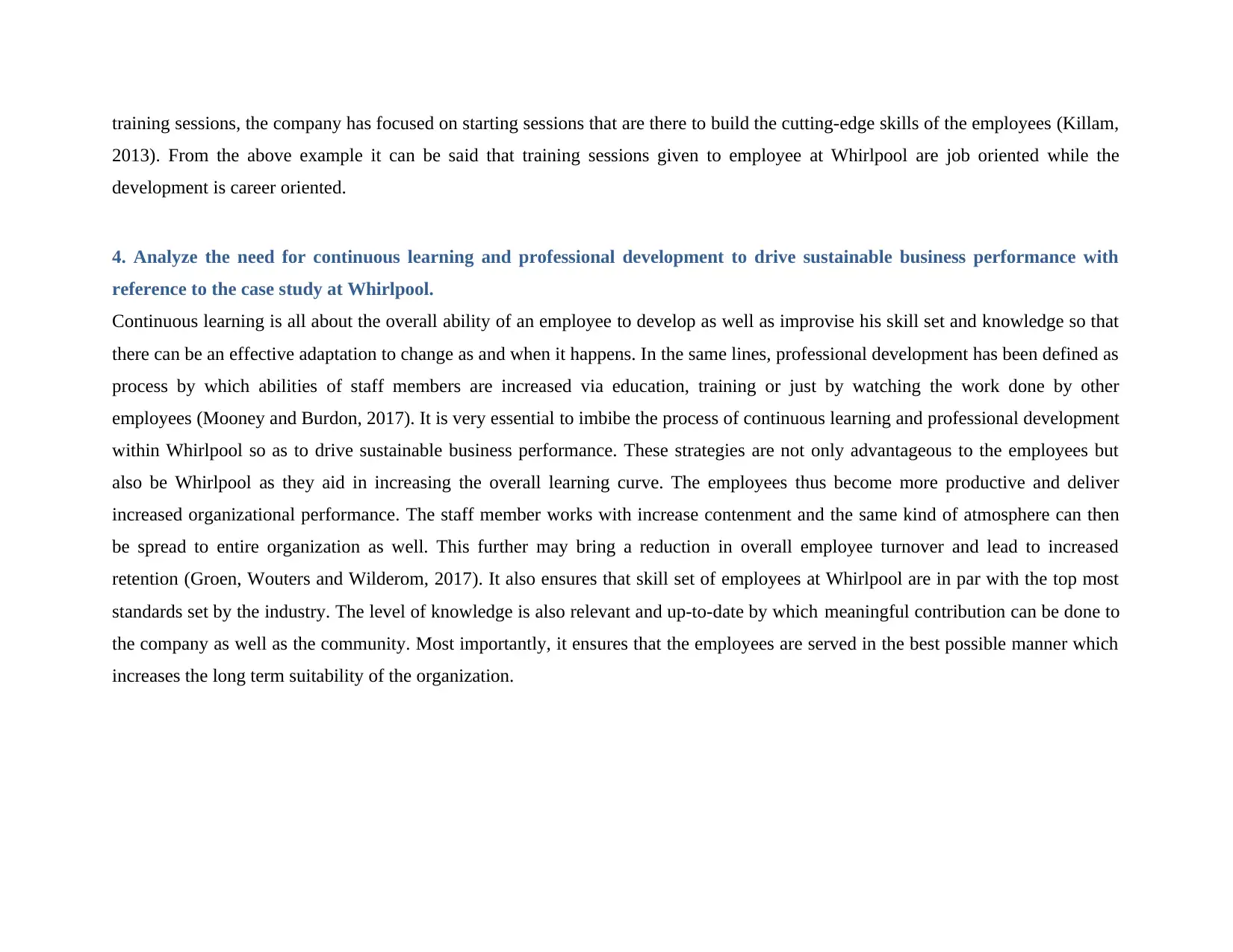
training sessions, the company has focused on starting sessions that are there to build the cutting-edge skills of the employees (Killam,
2013). From the above example it can be said that training sessions given to employee at Whirlpool are job oriented while the
development is career oriented.
4. Analyze the need for continuous learning and professional development to drive sustainable business performance with
reference to the case study at Whirlpool.
Continuous learning is all about the overall ability of an employee to develop as well as improvise his skill set and knowledge so that
there can be an effective adaptation to change as and when it happens. In the same lines, professional development has been defined as
process by which abilities of staff members are increased via education, training or just by watching the work done by other
employees (Mooney and Burdon, 2017). It is very essential to imbibe the process of continuous learning and professional development
within Whirlpool so as to drive sustainable business performance. These strategies are not only advantageous to the employees but
also be Whirlpool as they aid in increasing the overall learning curve. The employees thus become more productive and deliver
increased organizational performance. The staff member works with increase contenment and the same kind of atmosphere can then
be spread to entire organization as well. This further may bring a reduction in overall employee turnover and lead to increased
retention (Groen, Wouters and Wilderom, 2017). It also ensures that skill set of employees at Whirlpool are in par with the top most
standards set by the industry. The level of knowledge is also relevant and up-to-date by which meaningful contribution can be done to
the company as well as the community. Most importantly, it ensures that the employees are served in the best possible manner which
increases the long term suitability of the organization.
2013). From the above example it can be said that training sessions given to employee at Whirlpool are job oriented while the
development is career oriented.
4. Analyze the need for continuous learning and professional development to drive sustainable business performance with
reference to the case study at Whirlpool.
Continuous learning is all about the overall ability of an employee to develop as well as improvise his skill set and knowledge so that
there can be an effective adaptation to change as and when it happens. In the same lines, professional development has been defined as
process by which abilities of staff members are increased via education, training or just by watching the work done by other
employees (Mooney and Burdon, 2017). It is very essential to imbibe the process of continuous learning and professional development
within Whirlpool so as to drive sustainable business performance. These strategies are not only advantageous to the employees but
also be Whirlpool as they aid in increasing the overall learning curve. The employees thus become more productive and deliver
increased organizational performance. The staff member works with increase contenment and the same kind of atmosphere can then
be spread to entire organization as well. This further may bring a reduction in overall employee turnover and lead to increased
retention (Groen, Wouters and Wilderom, 2017). It also ensures that skill set of employees at Whirlpool are in par with the top most
standards set by the industry. The level of knowledge is also relevant and up-to-date by which meaningful contribution can be done to
the company as well as the community. Most importantly, it ensures that the employees are served in the best possible manner which
increases the long term suitability of the organization.
Secure Best Marks with AI Grader
Need help grading? Try our AI Grader for instant feedback on your assignments.
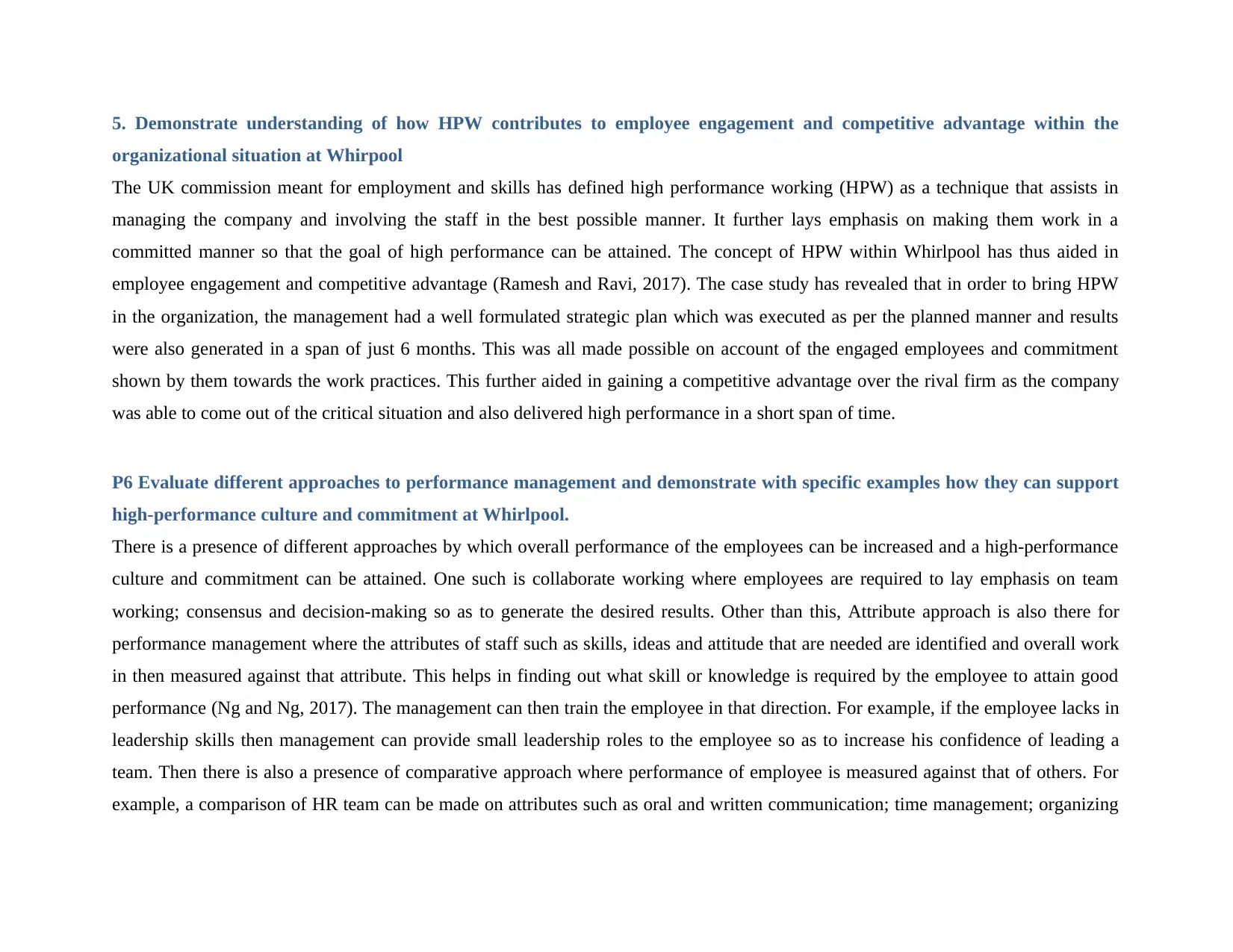
5. Demonstrate understanding of how HPW contributes to employee engagement and competitive advantage within the
organizational situation at Whirpool
The UK commission meant for employment and skills has defined high performance working (HPW) as a technique that assists in
managing the company and involving the staff in the best possible manner. It further lays emphasis on making them work in a
committed manner so that the goal of high performance can be attained. The concept of HPW within Whirlpool has thus aided in
employee engagement and competitive advantage (Ramesh and Ravi, 2017). The case study has revealed that in order to bring HPW
in the organization, the management had a well formulated strategic plan which was executed as per the planned manner and results
were also generated in a span of just 6 months. This was all made possible on account of the engaged employees and commitment
shown by them towards the work practices. This further aided in gaining a competitive advantage over the rival firm as the company
was able to come out of the critical situation and also delivered high performance in a short span of time.
P6 Evaluate different approaches to performance management and demonstrate with specific examples how they can support
high-performance culture and commitment at Whirlpool.
There is a presence of different approaches by which overall performance of the employees can be increased and a high-performance
culture and commitment can be attained. One such is collaborate working where employees are required to lay emphasis on team
working; consensus and decision-making so as to generate the desired results. Other than this, Attribute approach is also there for
performance management where the attributes of staff such as skills, ideas and attitude that are needed are identified and overall work
in then measured against that attribute. This helps in finding out what skill or knowledge is required by the employee to attain good
performance (Ng and Ng, 2017). The management can then train the employee in that direction. For example, if the employee lacks in
leadership skills then management can provide small leadership roles to the employee so as to increase his confidence of leading a
team. Then there is also a presence of comparative approach where performance of employee is measured against that of others. For
example, a comparison of HR team can be made on attributes such as oral and written communication; time management; organizing
organizational situation at Whirpool
The UK commission meant for employment and skills has defined high performance working (HPW) as a technique that assists in
managing the company and involving the staff in the best possible manner. It further lays emphasis on making them work in a
committed manner so that the goal of high performance can be attained. The concept of HPW within Whirlpool has thus aided in
employee engagement and competitive advantage (Ramesh and Ravi, 2017). The case study has revealed that in order to bring HPW
in the organization, the management had a well formulated strategic plan which was executed as per the planned manner and results
were also generated in a span of just 6 months. This was all made possible on account of the engaged employees and commitment
shown by them towards the work practices. This further aided in gaining a competitive advantage over the rival firm as the company
was able to come out of the critical situation and also delivered high performance in a short span of time.
P6 Evaluate different approaches to performance management and demonstrate with specific examples how they can support
high-performance culture and commitment at Whirlpool.
There is a presence of different approaches by which overall performance of the employees can be increased and a high-performance
culture and commitment can be attained. One such is collaborate working where employees are required to lay emphasis on team
working; consensus and decision-making so as to generate the desired results. Other than this, Attribute approach is also there for
performance management where the attributes of staff such as skills, ideas and attitude that are needed are identified and overall work
in then measured against that attribute. This helps in finding out what skill or knowledge is required by the employee to attain good
performance (Ng and Ng, 2017). The management can then train the employee in that direction. For example, if the employee lacks in
leadership skills then management can provide small leadership roles to the employee so as to increase his confidence of leading a
team. Then there is also a presence of comparative approach where performance of employee is measured against that of others. For
example, a comparison of HR team can be made on attributes such as oral and written communication; time management; organizing
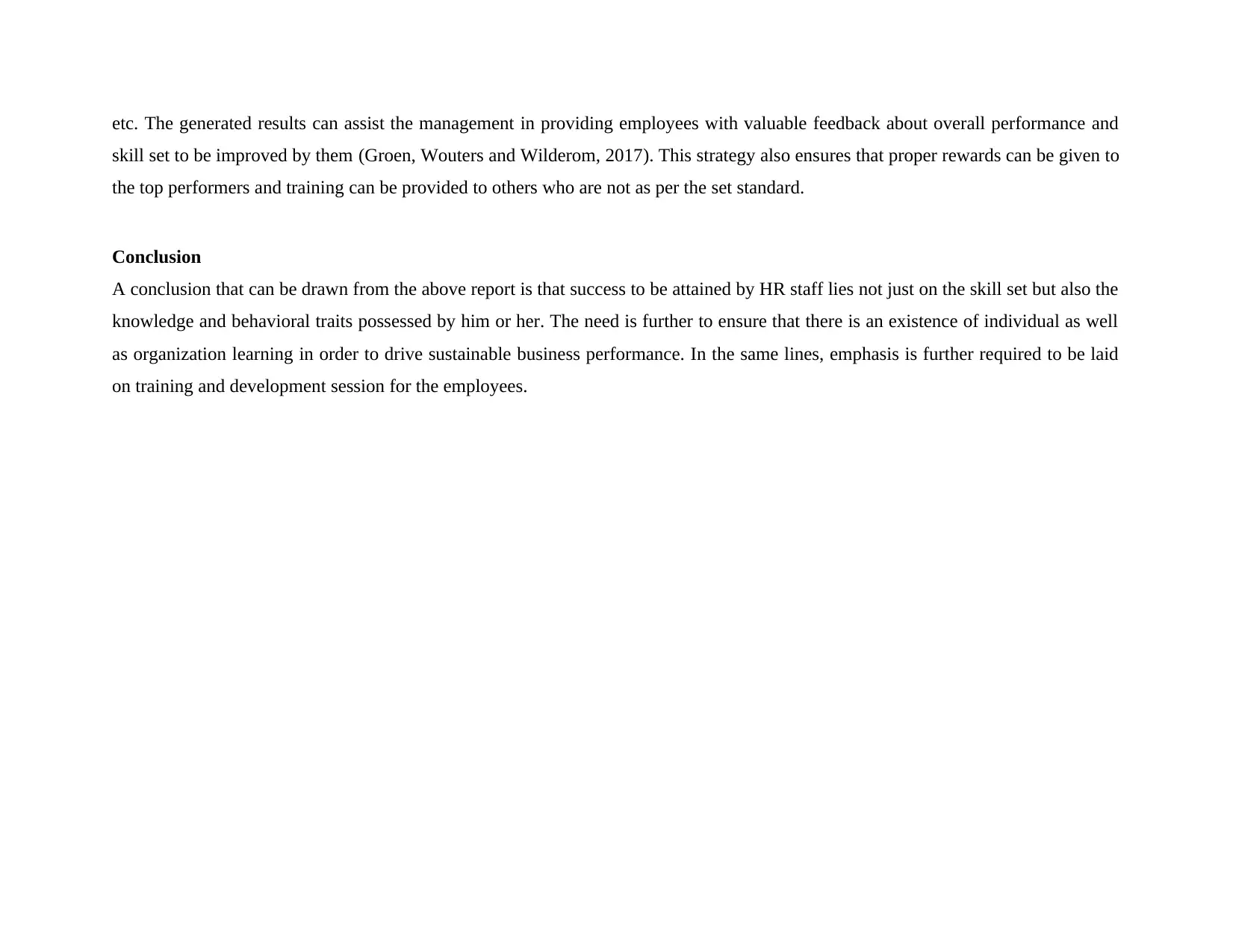
etc. The generated results can assist the management in providing employees with valuable feedback about overall performance and
skill set to be improved by them (Groen, Wouters and Wilderom, 2017). This strategy also ensures that proper rewards can be given to
the top performers and training can be provided to others who are not as per the set standard.
Conclusion
A conclusion that can be drawn from the above report is that success to be attained by HR staff lies not just on the skill set but also the
knowledge and behavioral traits possessed by him or her. The need is further to ensure that there is an existence of individual as well
as organization learning in order to drive sustainable business performance. In the same lines, emphasis is further required to be laid
on training and development session for the employees.
skill set to be improved by them (Groen, Wouters and Wilderom, 2017). This strategy also ensures that proper rewards can be given to
the top performers and training can be provided to others who are not as per the set standard.
Conclusion
A conclusion that can be drawn from the above report is that success to be attained by HR staff lies not just on the skill set but also the
knowledge and behavioral traits possessed by him or her. The need is further to ensure that there is an existence of individual as well
as organization learning in order to drive sustainable business performance. In the same lines, emphasis is further required to be laid
on training and development session for the employees.
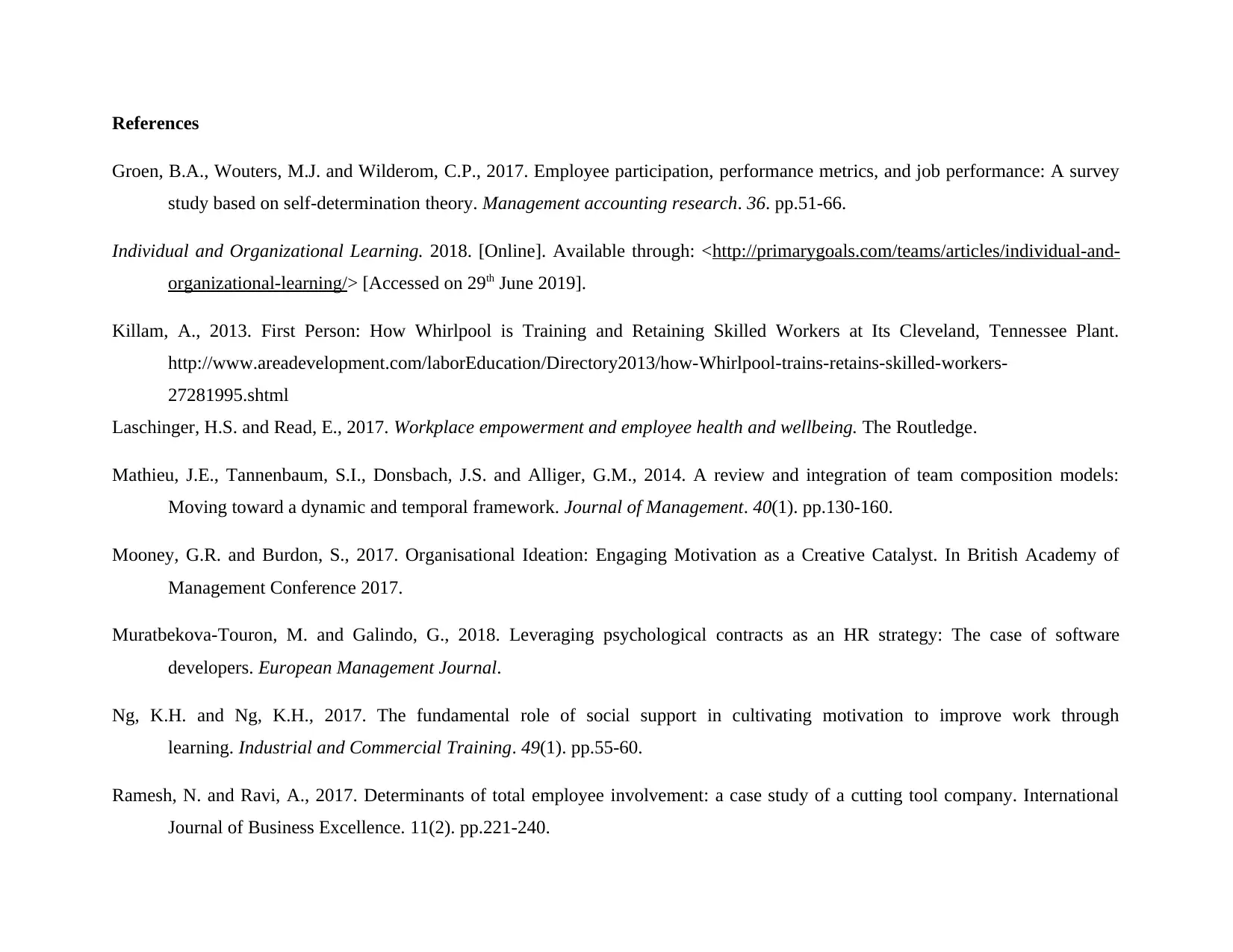
References
Groen, B.A., Wouters, M.J. and Wilderom, C.P., 2017. Employee participation, performance metrics, and job performance: A survey
study based on self-determination theory. Management accounting research. 36. pp.51-66.
Individual and Organizational Learning. 2018. [Online]. Available through: <http://primarygoals.com/teams/articles/individual-and-
organizational-learning/> [Accessed on 29th June 2019].
Killam, A., 2013. First Person: How Whirlpool is Training and Retaining Skilled Workers at Its Cleveland, Tennessee Plant.
http://www.areadevelopment.com/laborEducation/Directory2013/how-Whirlpool-trains-retains-skilled-workers-
27281995.shtml
Laschinger, H.S. and Read, E., 2017. Workplace empowerment and employee health and wellbeing. The Routledge.
Mathieu, J.E., Tannenbaum, S.I., Donsbach, J.S. and Alliger, G.M., 2014. A review and integration of team composition models:
Moving toward a dynamic and temporal framework. Journal of Management. 40(1). pp.130-160.
Mooney, G.R. and Burdon, S., 2017. Organisational Ideation: Engaging Motivation as a Creative Catalyst. In British Academy of
Management Conference 2017.
Muratbekova-Touron, M. and Galindo, G., 2018. Leveraging psychological contracts as an HR strategy: The case of software
developers. European Management Journal.
Ng, K.H. and Ng, K.H., 2017. The fundamental role of social support in cultivating motivation to improve work through
learning. Industrial and Commercial Training. 49(1). pp.55-60.
Ramesh, N. and Ravi, A., 2017. Determinants of total employee involvement: a case study of a cutting tool company. International
Journal of Business Excellence. 11(2). pp.221-240.
Groen, B.A., Wouters, M.J. and Wilderom, C.P., 2017. Employee participation, performance metrics, and job performance: A survey
study based on self-determination theory. Management accounting research. 36. pp.51-66.
Individual and Organizational Learning. 2018. [Online]. Available through: <http://primarygoals.com/teams/articles/individual-and-
organizational-learning/> [Accessed on 29th June 2019].
Killam, A., 2013. First Person: How Whirlpool is Training and Retaining Skilled Workers at Its Cleveland, Tennessee Plant.
http://www.areadevelopment.com/laborEducation/Directory2013/how-Whirlpool-trains-retains-skilled-workers-
27281995.shtml
Laschinger, H.S. and Read, E., 2017. Workplace empowerment and employee health and wellbeing. The Routledge.
Mathieu, J.E., Tannenbaum, S.I., Donsbach, J.S. and Alliger, G.M., 2014. A review and integration of team composition models:
Moving toward a dynamic and temporal framework. Journal of Management. 40(1). pp.130-160.
Mooney, G.R. and Burdon, S., 2017. Organisational Ideation: Engaging Motivation as a Creative Catalyst. In British Academy of
Management Conference 2017.
Muratbekova-Touron, M. and Galindo, G., 2018. Leveraging psychological contracts as an HR strategy: The case of software
developers. European Management Journal.
Ng, K.H. and Ng, K.H., 2017. The fundamental role of social support in cultivating motivation to improve work through
learning. Industrial and Commercial Training. 49(1). pp.55-60.
Ramesh, N. and Ravi, A., 2017. Determinants of total employee involvement: a case study of a cutting tool company. International
Journal of Business Excellence. 11(2). pp.221-240.
Paraphrase This Document
Need a fresh take? Get an instant paraphrase of this document with our AI Paraphraser
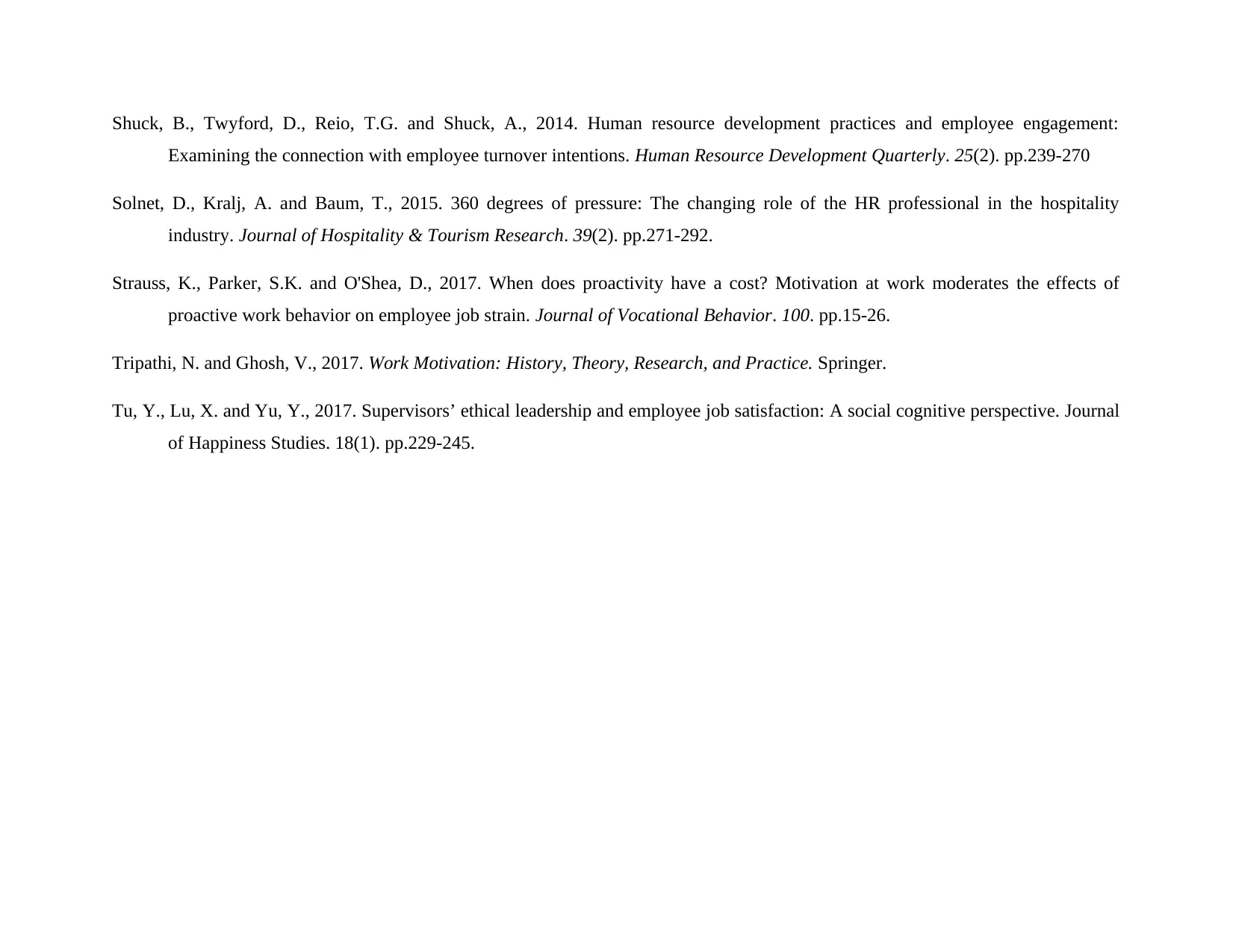
Shuck, B., Twyford, D., Reio, T.G. and Shuck, A., 2014. Human resource development practices and employee engagement:
Examining the connection with employee turnover intentions. Human Resource Development Quarterly. 25(2). pp.239-270
Solnet, D., Kralj, A. and Baum, T., 2015. 360 degrees of pressure: The changing role of the HR professional in the hospitality
industry. Journal of Hospitality & Tourism Research. 39(2). pp.271-292.
Strauss, K., Parker, S.K. and O'Shea, D., 2017. When does proactivity have a cost? Motivation at work moderates the effects of
proactive work behavior on employee job strain. Journal of Vocational Behavior. 100. pp.15-26.
Tripathi, N. and Ghosh, V., 2017. Work Motivation: History, Theory, Research, and Practice. Springer.
Tu, Y., Lu, X. and Yu, Y., 2017. Supervisors’ ethical leadership and employee job satisfaction: A social cognitive perspective. Journal
of Happiness Studies. 18(1). pp.229-245.
Examining the connection with employee turnover intentions. Human Resource Development Quarterly. 25(2). pp.239-270
Solnet, D., Kralj, A. and Baum, T., 2015. 360 degrees of pressure: The changing role of the HR professional in the hospitality
industry. Journal of Hospitality & Tourism Research. 39(2). pp.271-292.
Strauss, K., Parker, S.K. and O'Shea, D., 2017. When does proactivity have a cost? Motivation at work moderates the effects of
proactive work behavior on employee job strain. Journal of Vocational Behavior. 100. pp.15-26.
Tripathi, N. and Ghosh, V., 2017. Work Motivation: History, Theory, Research, and Practice. Springer.
Tu, Y., Lu, X. and Yu, Y., 2017. Supervisors’ ethical leadership and employee job satisfaction: A social cognitive perspective. Journal
of Happiness Studies. 18(1). pp.229-245.
1 out of 14
Related Documents
Your All-in-One AI-Powered Toolkit for Academic Success.
+13062052269
info@desklib.com
Available 24*7 on WhatsApp / Email
![[object Object]](/_next/static/media/star-bottom.7253800d.svg)
Unlock your academic potential
© 2024 | Zucol Services PVT LTD | All rights reserved.





